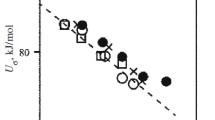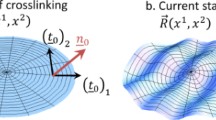Abstract
We present a theory to account for how a stress field can induce plastic flow in glassy polymers. We consider a molecular model in which chains are constituted from isotropic oriented elementary links embedded in a deforming continuum. The shear-stress field causes a redistribution of such links governed by a balance equation in orientation space. After detail calculations of the number of oriented units in certain directions, the net jump rate of the molecular links is given by an exponential form, according to the transition state theories of Adam and Gibbs [6]. These considerations are compared with the study of Boyce et al. [5] that included the effects of deformation rate, pressure and strain softening. The calculation of the plastic properties for polymethyl methacrylate and polycarbonate for various types of deformation has been made, and the corresponding results fitted the experimental data reasonably well.
Similar content being viewed by others
References
H. EYRING, J. Chem. Phys. 4 (1936) 283.
R. E. ROBERTSON, ibid. 44 (1966) 3950.
R. A. DUCKETT, S. RABINOWITZ and I. M. WARD, J. Mater. Sci. 5 (1970) 909.
A. S. ARGON, Phil. Mag. 28 (1973) 39.
M. C. BOYCE, D. M. PARKS and A. S. ARGON, Mech. Mater. 7 (1988) 15.
G. ADAMS and J. H. GIBBS, J. Chem. Phys. 43 (1965) 139.
M. COHEN and D. TURNBULL, J. Chem. Phys. 31 (1959) 1164.
F. BUECHE, “Physical properties of polymers” (Wiley, New York, 1962).
P. D. WU and E. Van Der GIESSEN, J. Mech. Phys. Solids 41 (1993) 456.
I. DAFALIAS, Lectures on continuum mechanics, National Tech. Univ. of Athens, Athens (1993).
J. CM. LI and J. J. GILMAN, J. App. Phys. 41 (1970) 4248.
I. M. WARD, “Mechanical properties of solid polymers” (Wiley, New York, 1983) p. 283.
S. RABINOWITZ, I. M. WARD and J. C. S. PARRY, J. Mater. Sci. 5 (1970) 29.
E. H. LEE, J. Appl. Mech. 36 (1969) 1.
L. ANAND, ibid. 46 (1979) 78.
R. N. HAWARD, “The physics of glassy polymers” (Applied Science, London, 1973).
R. N. HAWARD and G. THACKRAY, Proc. R. Soc. Lond. A 303 (1968) 453.
M. C. WANG and E. J. GUTH, J. Chem. Phys. 20 (1952) 1144.
E. M. ARRUDA and M. C. BOYCE, in “Anisotropy and localization of deformation”, edited by J. P. Boehler and A. S. Khan (Elsevier Applied Science, London, 1991).
P. S. HOPE, I. M. WARD and A. G. GIBSON, J. Mater. Sci. 15 (1980) 2207.
C. G’ SELL and A. J. GOPEZ, ibid. 20 (1985) 3462.
Author information
Authors and Affiliations
Rights and permissions
About this article
Cite this article
SPATHIS, G. Theory for the plastic deformation of glassy polymers. Journal of Materials Science 32, 1943–1950 (1997). https://doi.org/10.1023/A:1018533613296
Issue Date:
DOI: https://doi.org/10.1023/A:1018533613296




